When Cake Bulge Will It Bulge Again

Ever decorated a lovely cake with fondant but to detect air pockets on the sides and bulges effectually the base of the cake? These must exist two of the most frustrating challenges faced by block decorators. Even the most experienced block decorators have to bargain with these issues on a regular basis. In this post, I would be sharing some tricks I have learnt over fourth dimension on how to avert these from occurring, and if they practise occur, how to fix them. Though the tricks I will exist sharing beneath are past no means exhaustive, you will find that applying them when decorating your cakes volition result in smoother fondant covered cakes. For the purpose of clarity, each trick volition exist discussed under a different subheading.
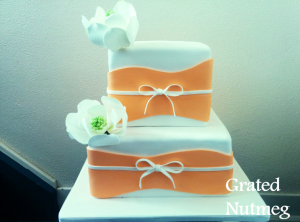
Before going on to talk over the tricks, it is pertinent that I explicate why air bubble and bulges occur in fondant covered cakes. The simple caption is that air pockets and bulges are acquired past four major factors: (1) Trapped air trying to escape from the cake; (2) The cake sponges and frosting settling; (3) Change in conditions weather condition; and (4) Inadequate cake structure and support. Trapped air is the major crusade of air pockets in cakes. You might wonder how air gets trapped in cakes. It's really quite unproblematic: if in that location are gaps between the cake layers and the frosting/filling, air would go trapped in those spaces. As the cake comes to room temperature and settles, the sponges would printing on the frosting/filling forcing out the air. Due to how well fondant seals cakes, this forced out air is trapped underneath the fondant with no where to escape and appear on the tiptop and sides of the cake as pockets. Also, if you reside in hot climates, there is the tendency for your frosting to melt as the block comes to room temperature. If yous utilize a lot of frosting underneath your fondant, the melting frosting would collect at the base of operations of the block which is part of what causes bulges around the base of cakes. Finally, if your cake support organisation is inadequate (dowels too short or block boards besides pocket-sized), it could lead to folds and bulges effectually the acme and base of operations of your cake.
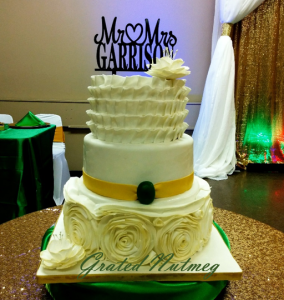
TRICKS:
(1) ALLOW YOUR SPONGES TO REST Before FROSTING
Inquire most experienced bakers and they will tell you that they never bake their cakes, frost them and cover them with fondant on the same day. Cakes need time to rest between each stage. Every bit a cake cools downward, it shrinks. Frosting a cake that is yet to shrink properly would affect the structure of the cake. A block that is baked, frosted and covered with fondant on the same day would most likely develop air pockets considering every bit the block settles information technology would force out air which would go trapped underneath the fondant covering. Develop a system in which you bake your sponges on i day, level and frost them on another and encompass them with fondant on yet another. For instance, if yous need to deliver a cake on Saturday, broil it on Wednesday, frost it on Th, cover it with fondant and decorate it on Friday. Add the terminal details on Sabbatum.
Past spacing out the cake making project this fashion, you would be achieving a lot of things. Start, your cake layers would have shrunk to their existent sizes, thus eliminating the possibility of developing air pockets later on frosting and decorating. 2nd, information technology is ever easier to work with a common cold block than with a block at room temperature: easier to level, easier to frost, easier to manage, easier to elevator and easier to stack. Third, you would reduce the pressure involved in trying to reach a lot within a mean solar day which in plough would lead to amend executed cakes which you and your client would be proud of.
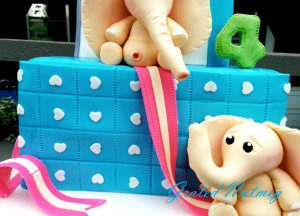
Discover the big air pocket in front of this cake tier? I would have avoided this past allowing my tiers to settle before frosting and decorating.
Later baking your sponges, permit them to cool completely on wire racks, wrap them tightly in cling film and place them in the fridge overnight. Do non wrap warm cakes in cling film or they would sweat which in turn would encourage bacterial growth and/or reduce the shelf life of your cake. Do not place your sponge in the fridge without wrapping information technology tightly. This volition make your cake dry.
(two) Allow YOUR FROSTED TIERS TO Rest BEFORE COVERING WITH FONDANT
As stated above, do not frost your cakes and cover them with fondant on the same day. This should only exist washed in cases where time is of the essence. After filling and frosting your cake tiers, place them in the fridge so they settle and so the frosting hardens around the cake. If you lot endeavor to decorate a block while the frosting is still soft, you will create dents in the frosting while applying your fondant. These dents would in plow trap air which would create air bubbles. In improver, you will not end upward with a smooth finish. Allowing your frosted cakes to rest volition also ensure that all the air in the cake is pushed out of the cake as the sponges printing on the frosting/filling.
A trick I usually use is to make a hole down the middle of a nibble coated cake before placing it in the refrigerator. This would help air escape as the cake settles. Yous can read more than virtually this trick here. I also brand similar holes in the eye of my tiers later roofing them with fondant for the same reason. A refrigerator is essential when frosting and decorating cakes. My cakes constantly move from the turn table to the fridge and back. Endeavour your all-time to go on your cakes chill throughout the decorating process. This would help proceed the structure of the cake.
(3) TORT, LEVEL AND FROST Cake LAYERS PROPERLY
It is important to properly torte your block layers. Uneven cake layers would lead to spaces in the cake tier later on frosting which in turn would create air bubbles after fondant has been applied. I have a detailed mail service here on how to torte and level cake tiers and another post here on how to frost cake tiers properly. When leveling your cake layers, exist certain to cut off all the doom/crown from the top of the block. Practise not exist stingy when cutting off the doom. What y'all desire to achieve on all your cake layers are straight sides. There should be no curves at the top or betwixt each layer. Stuffing gaps along the sides of cake tiers with frosting would merely lead to weakness in the cake structure and increment the likelihood of air bubbles.
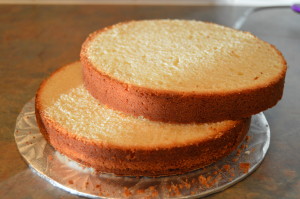
When frosting and filling your layers, brand sure your frosting and fillings are leveled and shine. When you place each layer on a frosted/filled layer, be sure to press that top layer downwardly on the frosting. This would ensure that all air pockets are eliminated. There should be no gap whatsoever between your layers and frosting. If you are filling the cake with things other than frosting, ever create a dam effectually the filling with frosting. This would trap the filling in and prevent the sides of the cake from bulging. When frosting the sides of tiers, be stingy with your frosting. Your goal should exist to accomplish a very smooth outside frosting with every bit little frosting every bit possible. If you apply a lot of frosting to the exterior of your block, the frosting would cook equally the cake comes to room temperature and collect at the bottom of the block which would lead to bulges. There is also the likelihood that the fondant would verbal pressure on the frosting equally the cake cools leading to bulges on the sides of the cake.

Notice the bulge at the base of this block. It was the event of too much frosting underneath the fondant.
(iv) ELIMINATE SPACES BETWEEN THE FONDANT AND CAKE TIER
When draping a frosted cake with fondant, exist sure that the fondant comes in contact with the entire body of the cake. To achieve this, always brush your frosted cake with a bit of h2o before draping it with fondant. You practise non however want to soak the frosting with water as this could encourage bacterial growth. Use a pastry brush and brush the entire surface area of the cake with as little water as possible. This would help ensure that the fondant sticks to the body of the cake without leaving gaps. Gaps would trap air. The cake can as well be brushed with other liquids.
When draping fondant over cake tiers, utilise a fondant smoother to smooth the summit of the block earlier stretching the fondant to cover the sides. This will remove trapped in air from the top of the block. Failure to practise this would atomic number 82 to air bubbles on top of the cake and around the top edges of the block. This in turn will prevent you from having precipitous edges which we all want equally bakers. As well, exist sure to make your fondant roofing as smooth every bit possible. Folds, overlaps and bumps would trap air around the cake.
(five) STACK AND DOWEL CAKE TIERS PROPERLY
A lot could go wrong if a block tier is not properly stacked or doweled. If any of your dowel is too short, the tier on acme would press down on the tier below. This added pressure would create air pockets effectually the elevation of the tier below (information technology would also brand your cake tiers to tilt). Be sure to employ a cake bill of fare underneath each tier before stacking it. Your cake tiers should never rest on each other. Ideally, the structure of your block should exist a network of dowels resting on cake cards and boards. The tiers should never accept to acquit the weight of the tiers above them. I have a very comprehensive post here on how to properly dowel and stack tiers.
Your choice of block boards is likewise very important. Your cake boards should always be at least 2 inches larger than the size of the bottom tier. They should also be stiff enough to conduct the weight of the whole cake. If you utilize a weak cake card as your cake board or a cake drum that is too small, y'all will create folds and bulges along the base of the cake each time y'all lift upward the cake to transfer or transport information technology. Y'all can read more about how to properly use cake boards hither.

Find burl at the base of operations of the cake. This happened because I used a thin cake bill of fare instead of a cake drum as my cake board.
(half dozen) QUICK FIXES
Even after obeying all the rules above, sometimes air pockets still happen. Below are a few quick fixes if this occurs.
i. Some frosting like foam cheese frosting practise non crust and thus pb to dents during fondant application. Consider filling your cake and nibble coating information technology with cream cheese frosting and applying another layer of buttercream frosting around the foam cheese frosting after the cake has chilled. This would provide better structure for the fondant. I just shared a huge trade underground with you.
two. Ever have a toothpick or needle on mitt. As shortly as yous observe air pockets, prick them and push out the air gently with your fingers or fondant smoother.
iii. When decorating cakes which have a long time to decorate, air pockets tin can class forth the way as the cake comes to room temperature. Consider returning the cake to the refrigerator at intervals to keep information technology cold always. I have read a lot of views near non keeping fondant covered cakes in the fridge. If you have seen any of my cakes, they all stay in the fridge until they are picked upwards. I repeat again for emphasis, the fridge is your friend as a block decorator.
iv. Not every ornamentation you see on a block was planned. There is a lot that can be covered with flowers, ornaments, tags et cetera. If a large burl has created a dent or tear on your cake, think of creative was of covering that flaw with decorations. Sometimes, I wrap my cake tiers with soft fondant panels to hide flaws. It's ok, no one needs to know.
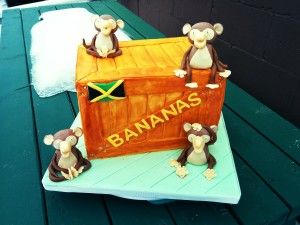
The flag in forepart of this cake is roofing a hole.
v. Sometimes, you merely accept to start all over once again. There are air pockets and bulges which cannot exist fixed. I know its hard, but some times you but have to accept off the fondant, work on the cake structure and employ the fondant all over over again.
You lot must have developed your own tricks for avoiding cake bulges and air pockets. Delight feel costless to add to this body of knowledge in the annotate department below. Thank you, Terry.
Source: http://www.gratednutmeg.com/?p=10405
0 Response to "When Cake Bulge Will It Bulge Again"
Post a Comment